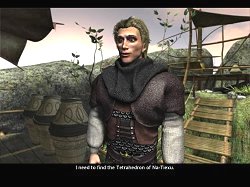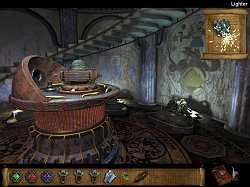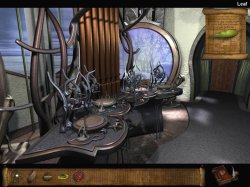|
Aura: Fate of the Ages
 Aura: Fate of the Ages is an adventure game that has a lot going for it; impressive graphics with seamlessly integrated cut scenes, interesting worlds to explore, varied and challenging puzzles, and some rather nice music for the most part. What it does right it does well. However there are some elements such as story development and character definition that could have been improved to provide a more satisfying experience. Aura: Fate of the Ages is an adventure game that has a lot going for it; impressive graphics with seamlessly integrated cut scenes, interesting worlds to explore, varied and challenging puzzles, and some rather nice music for the most part. What it does right it does well. However there are some elements such as story development and character definition that could have been improved to provide a more satisfying experience.
The short introduction tells of the Keepers, wise old men (no women, apparently) who guard the secrets of the universe. Through the use of powerful rings they are able to create and travel to new worlds. Legend has it that whoever combines these rings with sacred artefacts hidden on various worlds will achieve immortality and great power.
You are Umang, brightest student of the Clan of Keepers, and you are sent to Ademika, gateway to the hidden worlds, to continue your training with an old and wise master named Grifit. When you arrive Grifit has gone but he has left you a note telling you to prepare the journey ship and to activate the navigational map.
From there you are on your own. Although there are some tantalising puzzles the story is barely fleshed-out, the background of the Keepers and history of the society is almost non-existent. Yet it needn't have been so. A small library to explore or a few books scattered about could have been used to provide a little more context for the journey and perhaps some background with clues to orient the puzzles.
 You are not totally clue-less, however. Umang has a journal that updates periodically with a series of sketches that hint at what you may need to accomplish. They give just the right amount of information and leave you to work out the rest.
As you complete the tasks that have been set for you on Ademika, a guard appears telling you of an uprising led by Durad who wants to seize the rings. Your quest from here is to take them and find the tetrahedrons on the other worlds and prevent Durad from getting his hands on them. But Durad and his uprising take no real part in the rest of the game until the very end where it is clearly set up for a sequel. You are not totally clue-less, however. Umang has a journal that updates periodically with a series of sketches that hint at what you may need to accomplish. They give just the right amount of information and leave you to work out the rest.
As you complete the tasks that have been set for you on Ademika, a guard appears telling you of an uprising led by Durad who wants to seize the rings. Your quest from here is to take them and find the tetrahedrons on the other worlds and prevent Durad from getting his hands on them. But Durad and his uprising take no real part in the rest of the game until the very end where it is clearly set up for a sequel.
Aura is a first-person perspective, mouse-controlled game interspersed with third-person cut scenes for conversations and transitional flying sequences. Movement is from node to node and you can pan horizontally and vertically. There are some inventory-based puzzles but the emphasis is on manipulating machinery and mystical artefacts. There are some weird and wonderful contraptions with colourful lights, symbols and buttons, and some inventive puzzles. While at first glance there may appear to be an element of trial and error, this is not really the case as there are clues in the gameworld, in the nature of the puzzles themselves, and possibly in the sketches in your journal. You just need to be observant and logical in your approach to solving them. Also, it doesn't hurt to make notes or draw your own sketches of symbols or sequences or even colours that might help in making sense of the puzzles.
If you have been successful in your manipulations you will be rewarded with a cut scene showing the outcome. I really appreciated this feature because I knew instantly that a problem was solved and I didn't have to traipse half a world away to learn if a machine was now working or a door would now open.
For me, Ademika and the second world, Dragast, were the strongest in terms of absorbing and coherent manipulative puzzles. Na-Tiexu, the third world, eventually opens up into four separate but linked locations where there is some variety to the challenges. Here the use of inventory items is more important and there is a substantial match the tone problem. This one held me up the longest because I struggle recognising subtle differences in tones and this made it all the more difficult to spot the logic. There is also one other puzzle requiring recognition of sounds. The fourth world, the Island of Unity, isn't really a world to explore it merely provides the location for the end sequence.
 Unfortunately there is one hiccup that you're unlikely to miss in the mini world involving the lonely children. I'm not sure if I encountered a glitch but the final task seemed unfinished, even when I finished it. After performing a series of actions there should have been an indication that the crucial artefact was now available and some smiling children's faces to make you feel good, but this never happened. It took me a while to realise I could move on as I was still trying to help the children. In fact I repeated this short slice of play and discovered that you can circumvent all the intervening tasks and simply take the artefact if you use a particular object on it.
But this little stumble didn't deter me. The worlds of Aura are fascinating places, the twilight landscape of Ademika with brightly lit 'grottos' housing elaborate contraptions to tempt your puzzle solving skills, and the soaring world of Dragast with its massive machinery that must to be set in motion. These contrasted with the smaller worlds of astronomy and magic where there are various items to find and a few more manipulative puzzles.
There are no timed puzzles in Aura so you can explore at your leisure. There are a few characters to meet and talk to and I felt that more could have been done here to expand on the story and your role in it. As it is, your character, Umang, is perhaps the least interesting and that may simply be because we don't really get to learn anything about him.
I mentioned in my preview that you will sometimes be given an item and not know that you have it until you check your inventory. One of the items you get this way is a major plot device that I won't elaborate on here, but another is crucial to your progress and it would have been nice if this were indicated in some way. Perhaps the inventory could appear and the item could glow when you get it just as the journal does when it is updated with new information.
Your inventory is hidden for much of the game and only appears at the bottom of the screen when you click the right mouse button. If you move your cursor over an inventory item you can get a closer look at it. Unfortunately there is one hiccup that you're unlikely to miss in the mini world involving the lonely children. I'm not sure if I encountered a glitch but the final task seemed unfinished, even when I finished it. After performing a series of actions there should have been an indication that the crucial artefact was now available and some smiling children's faces to make you feel good, but this never happened. It took me a while to realise I could move on as I was still trying to help the children. In fact I repeated this short slice of play and discovered that you can circumvent all the intervening tasks and simply take the artefact if you use a particular object on it.
But this little stumble didn't deter me. The worlds of Aura are fascinating places, the twilight landscape of Ademika with brightly lit 'grottos' housing elaborate contraptions to tempt your puzzle solving skills, and the soaring world of Dragast with its massive machinery that must to be set in motion. These contrasted with the smaller worlds of astronomy and magic where there are various items to find and a few more manipulative puzzles.
There are no timed puzzles in Aura so you can explore at your leisure. There are a few characters to meet and talk to and I felt that more could have been done here to expand on the story and your role in it. As it is, your character, Umang, is perhaps the least interesting and that may simply be because we don't really get to learn anything about him.
I mentioned in my preview that you will sometimes be given an item and not know that you have it until you check your inventory. One of the items you get this way is a major plot device that I won't elaborate on here, but another is crucial to your progress and it would have been nice if this were indicated in some way. Perhaps the inventory could appear and the item could glow when you get it just as the journal does when it is updated with new information.
Your inventory is hidden for much of the game and only appears at the bottom of the screen when you click the right mouse button. If you move your cursor over an inventory item you can get a closer look at it.
Aura comes on 3 CDs and installs fully to your hard drive though you do need to leave the first CD in the drive in order to play. From the main menu that appears on start up (or any time you press the Esc key during play) you can adjust your sound and video options and enable subtitles. From this screen you also save, load and exit the game. There are unlimited save game slots and cut scenes can be skipped by pressing the space bar.
Despite my few complaints, Aura: Fate of the Ages is a fine first game from Streko Graphics. Really the emphasis is on the puzzles and they are mostly a lot fun to complete. Some of them give you a real buzz when you finally spot the answer and a couple might even test your endurance. Although I didn't get to know Umang very well, I'm looking forward to joining up with him again to continue his journey.
Copyright © Gordon Aplin 2004.
All rights reserved.
System Requirements:
Windows 98SE/ME/2000/XP, 800 MHz Pentium III (or Equivalent), 64MB RAM, (128MB recommended), 16x CD-ROM Drive (24x recommended), 2GB Hard Disk Space (2.5GB recommended), 32MB DirectX 8/9 compatible 3D Video Card (or higher) DirectSound compatible, DirectX 8.1 (or higher).
NOTE: Windows Installer 2.0 must be installed to start the installation of Aura: Fate of Ages. While this Windows Installer is commonly available on almost all computers, some older systems may not have it installed. It has been included on the CD 1 in the folder named 'installerupdate'.
|
